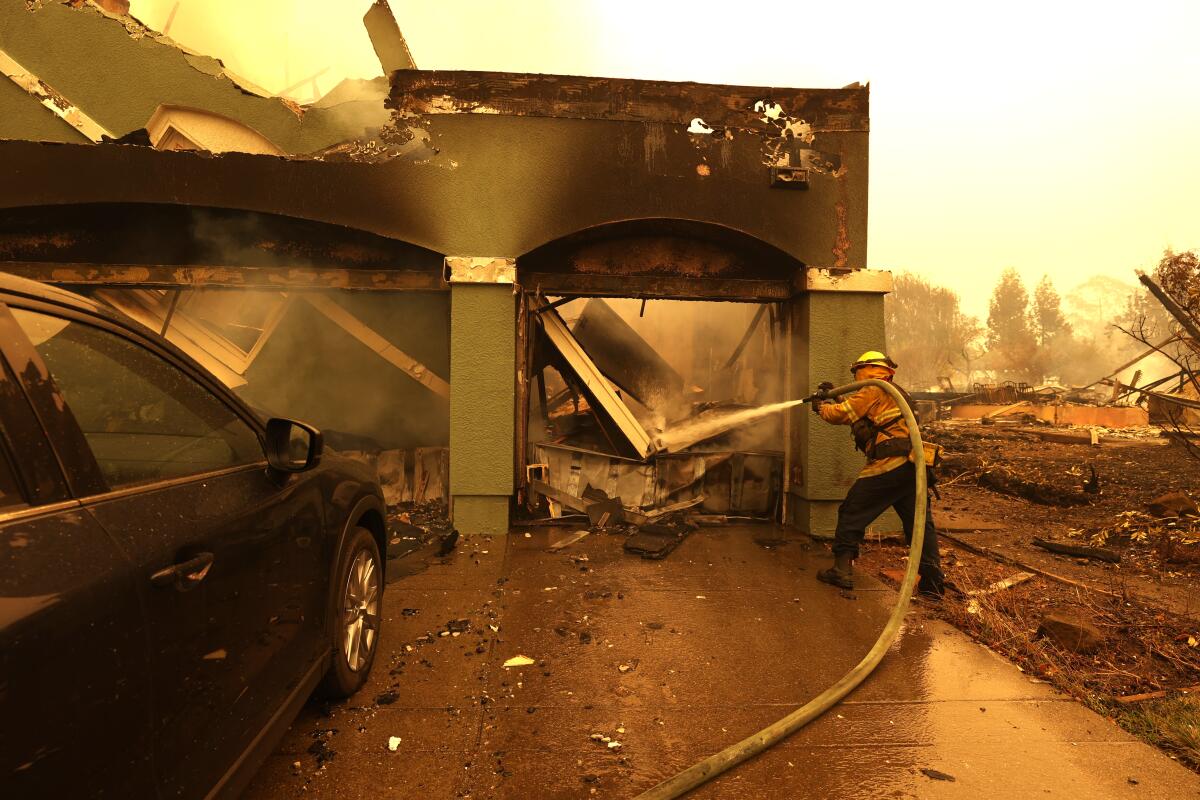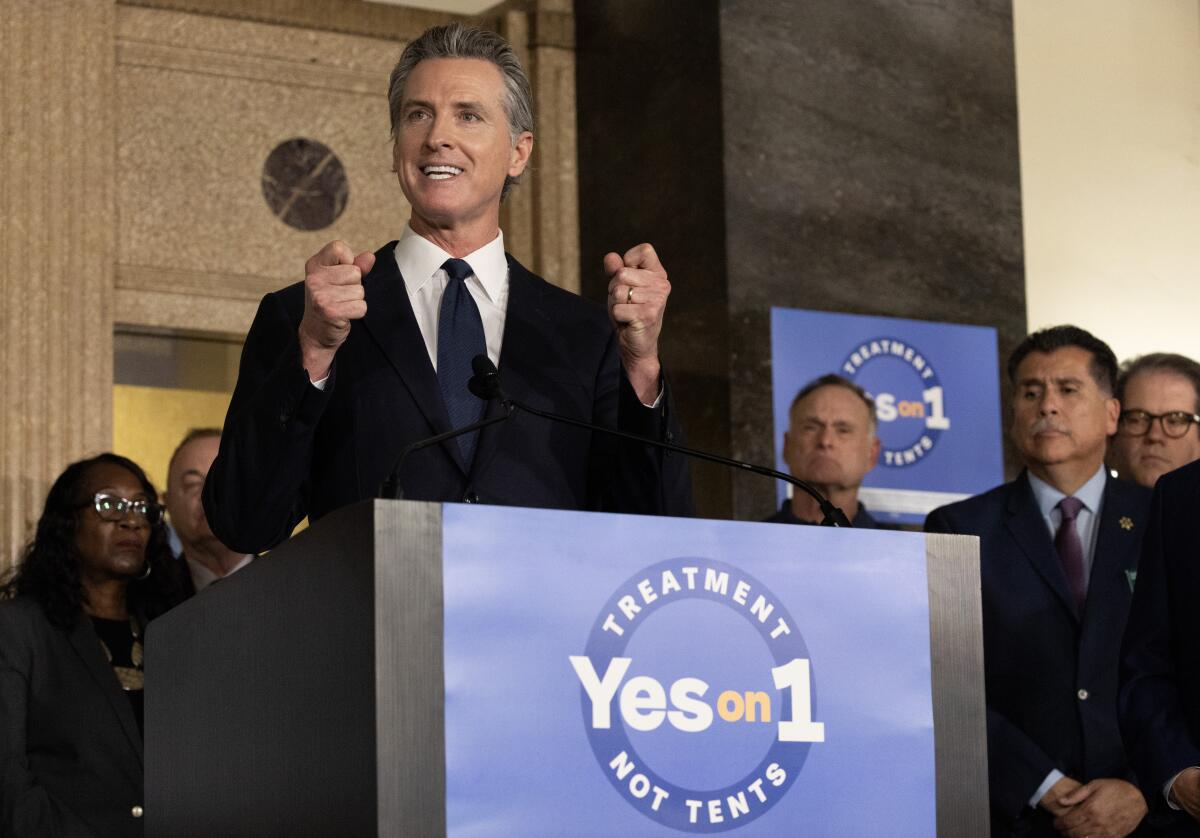California offers catastrophe plan to draw insurers back to the state. But at what cost?

- Share via
Good morning. It’s Friday, March 29. Here’s what you need to know to start your day.
- California intends to attract insurers back with flexible policies
- It is shaping up to be a wet Easter weekend in SoCal
- Nineteen best late-night hangouts in Koreatown
- And here’s today’s e-newspaper
Sign up for Essential California
The most important California stories and recommendations in your inbox every morning.
You may occasionally receive promotional content from the Los Angeles Times.
California intends to attract insurers back with flexible policies
The homeowners insurance crisis in California worsened last week when State Farm General Insurance announced that it wouldn’t renew 72,000 property owner policies statewide. Those policies are set to be canceled by summertime.
It’s not just State Farm.
Other insurers, like Allstate and USAA, have rapidly ceased new business in the Golden State, blaming the intensifying risk of insuring homes in the state’s increasingly dry, fuel-rich, fire-prone forests. We could be hurtling toward an “uninsurable future.”
Weeks ago, the California Department of Insurance, or CDI, proposed a regulation allowing insurers to use catastrophe models — computerized processes that simulate potential catastrophic events — to consider the projected impacts of climate change when requesting rate increases.
California hopes this will help lure insurers back.
If approved, insurers could submit catastrophe models for wildfires, floods and terrorism to the CDI and use predictions from these models to justify rate increases.
The state had already struck a deal in September to allow insurers to pass on the costs of reinsurance policies — which they use to help cover their own losses after major catastrophes — to customers in exchange for insurers returning to high-risk fire zones in California’s hills and canyons. The changes are slated to go into effect by the end of 2024.
Under Proposition 103, the state’s law governing the insurance industry, companies had been forbidden from passing on reinsurance costs to customers and were required to set rates based only on historical fire data.
The CDI believes changing this policy will provide more stable costs than current regulations, which have led to sudden and steep increases for those at higher risk of wildfire.
But advocates say catastrophe modeling isn’t always fair
Consumer Watchdog, an advocacy group, opposes catastrophe modeling, labeling it a violation of Proposition 103, and argues that the policy seems designed to restrict public access to information about how models affect rates.
“Catastrophe models are notoriously contradictory and unreliable, which is why public review and transparency are key before insurance companies are allowed to use them to raise rates,” the group wrote in a statement.
The regulation proposal is part of Insurance Commissioner Ricardo Lara’s Sustainable Insurance Strategy, a package of executive actions aimed at improving insurance choices and addressing the long-term sustainability of California’s insurance market.
Gov. Gavin Newsom issued an executive order in September commanding the insurance commissioner to “take prompt regulatory action to strengthen and stabilize California’s marketplace.”
“This issue isn’t just a yellow flag; it’s a waving red flag,” Newsom said at Climate Week NYC in September, speaking of the Legislature’s failure to address the slow-moving collapse of the property insurance market.
Insurers’ leaving the state has placed extra strain on many homeowners’ last-resort option
State Farm — the state’s longtime leading home insurer— had already announced last June that it would stop offering new property policies in the state due to the “rapidly growing catastrophe exposure and a challenging reinsurance market.”
USAA and Allstate also pulled back. Farmers capped the number of new policies written monthly. Travelers and Nationwide imposed new restrictions, making it harder for new customers to qualify for policies.
For the record:
9:20 a.m. March 29, 2024An earlier version of this article stated that Allstate stopped offering new property policies in California following State Farm’s June 2023 announcement. Allstate stopped offering new policies to California customers in November 2022.
“This could be the beginning of a market collapse that would leave millions stranded without affordable insurance as their homes burned to the ground,” Times reporter Sam Dean wrote last summer.
A scarcity of insurance choices has driven thousands to purchase limited insurance from the Fair Access to Insurance Requirement, or FAIR, Plan, with 350,000 Californians covered as of January 2024. The fund is a last resort insurance pool California requires insurance companies to contribute to based on their statewide market share.
However, a massive leap in enrollment from just under 273,000 two years ago has financially strained the state insurer. The president of the FAIR Plan Assn. warned lawmakers that the organization may be unable to financially survive a catastrophe.
Californians need insurance. Advocates say insurers can afford more.
Insurance remains the safest protection against personal calamities, whether climate-induced or otherwise, Times columnist Anita Chabria wrote last year. The state’s residents need insurers to remain in the market.
But climate change should not be a free pass for gouging consumers, Chabria said. Despite the cited disaster claims, she pointed out that insurance companies are still making money, albeit with worse profit margins than in the past.
During discussions last summer about the forward-looking models, Harvey Rosenfield, founder of Consumer Watchdog, stated: “This has nothing to do with climate change; it’s about the industry’s greed and its 35-year campaign — so far unsuccessful — to escape the requirements of Prop. 103.”
Today’s top stories
Proposition 1
- An advocacy group for California cities supported Prop. 1. Now some members are leaving.
- Your guide to Proposition 1: Newsom’s overhaul of California’s mental health system.
- Voters approve Proposition 1, Newsom’s overhaul of the California mental health system.
- Opinion: Californians narrowly passed Proposition 1. Can the state ensure the measure will work?
Nazi-looted art case
- California legislators push law change after ruling against a family in the Nazi-looted art case.
- A Jewish family, a famous European museum and the battle for a Nazi-looted masterpiece.
Baltimore bridge collapse
- How will the Baltimore bridge collapse affect prices and the West Coast?
- The Baltimore bridge collapse reminds us immigrants often do unheralded and dangerous work.
- Efforts are underway to remove Baltimore bridge ruins; search suspended for four workers presumed dead.
- Two bodies were pulled from the underwater wreckage of the collapsed Baltimore bridge.
- Would California bridges stand up to a direct hit? We asked experts.
Prison-bound crypto mogul
- Fallen crypto mogul Sam Bankman-Fried is sentenced to 25 years in prison.
- Michael Hiltzik: Sam Bankman-Fried will be sentenced Thursday for his crypto fraud. Throw the book at him.
Dodgers
- Ohtani says he’s cooperating with investigators. Yasiel Puig offers a cautionary tale.
- After a week of drama, Dodgers get back to the familiar and win their home opener.
- Photos: Opening Day 2024 at Dodger Stadium.
Fast food price increases
- Starbucks, Chipotle, McDonald’s: Who’s raising prices in California to pay higher wages.
- With fewer options, South L.A. braces for bigger bills at fast-food restaurants.
More big stories
- At least 14 hurt as MTA bus is part of multi-vehicle ‘rollover collision’ in South L.A.
- Hay grown for cattle consumes nearly half the water drawn from Colorado River, a study finds.
- Former top LAPD official accused of tracking woman with AirTag alleges cronyism by ex-chief.
- A former Cal State Northridge official was gunned down at L.A. Live. Two have been arrested.
- California proposal would change how power bills are calculated, aiming to relieve summer spikes.
- The U.S. changes how it categorizes people by race and ethnicity, its first revision in 27 years.
- The Broad expansion: What you need to know about the $100-million project.
- San Francisco just canceled its 420 fest. Marijuana fans thought it had gotten too commercial anyway.
- Rattlesnakes on Santa Catalina Island have learned that it pays to be unusually aggressive.
- AMC Theatres shares plummet as the theater chain reels from box office struggles.
- Easter weekend storm dousing plans in L.A.: When will it rain? What’s been canceled?
- Cesar Chavez’s family wants nothing to do with Robert F. Kennedy Jr.’s presidential campaign.
- LAX’s long-promised rail link, the People Mover, likely delayed until late 2025.
- Scientists say these killer whales are distinct species. It could save them.
- Blue jellyfish-like critters arrive in Bay Area. When will they show up on SoCal beaches?
- Homeless deaths in L.A. dropped, but many are dying from drugs.
- Louis Gossett Jr., ‘An Officer and a Gentleman’ star who broke barriers in Hollywood, dies.
Get unlimited access to the Los Angeles Times. Subscribe here.
Commentary and opinions
- Editorial: Bring buttons and dials back to new cars. Touch screens distract drivers.
- Jackie Calmes: Is this the worst Congress ever? Let’s count the ways.
- Erika D. Smith: What if Bruce’s Beach was just the start? Why more stolen land is about be returned.
- Editorial: At long last, women finally have a real shot at California’s top job.
Today’s great reads

Fisker had big dreams to compete with Tesla. What went wrong with this Manhattan Beach company? Multiple factors contributed to the company’s fall, analysts said, including the challenges of starting an auto company from scratch, fierce competition in the EV market and production difficulties with its flagship Ocean SUV.
Other great reads
- They escaped a world of fast fashion to teach L.A. how to give old clothes new life.
- When Martin Luther King Jr. came to L.A., only one white politician was willing to greet him.
- A final night at the Conga Room.
How can we make this newsletter more useful? Send comments to [email protected].
For your downtime

Going out
- 🍸Nineteen best late-night hangouts in Koreatown to keep the party going.
- 🦍‘Godzilla x Kong: The New Empire’ — in theaters Friday — is monster math that becomes a headache.
Staying in
- 📺 In Hulu’s ‘We Were the Lucky Ones,’ an engrossing family drama with the Holocaust as backdrop.
- 🧑🍳 Here’s a recipe for Roman-style chickpea and tomato soup with bulgur.
- ✏️ Get our free daily crossword puzzle, sudoku, word search and arcade games.
And finally ... a powerful photo
Show us your favorite place in California! We’re running low on submissions. Send us photos that scream California and we may feature them in an edition of Essential California.

Today’s powerful photo is from Times photographer Marcus Yam from the West Bank, where the olive harvest has suffered with the expansion of Israeli settlements.
Have a great day, from the Essential California team
Anthony De Leon, reporting fellow
Kevinisha Walker, multiplatform editor
Karim Doumar, head of newsletters
Check our top stories, topics and the latest articles on latimes.com.
Sign up for Essential California
The most important California stories and recommendations in your inbox every morning.
You may occasionally receive promotional content from the Los Angeles Times.





